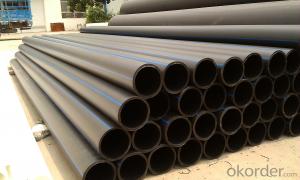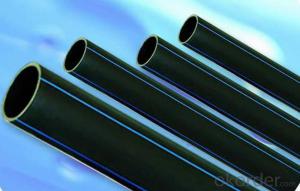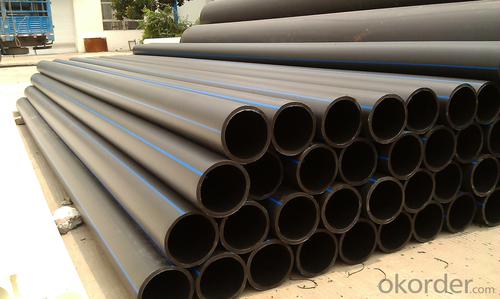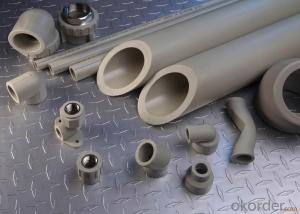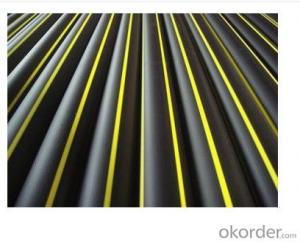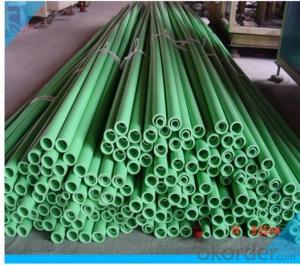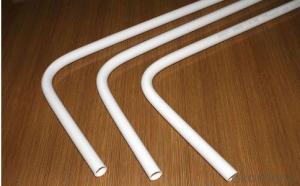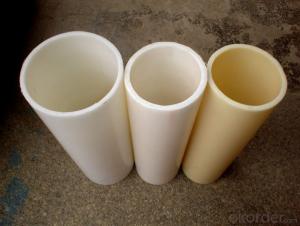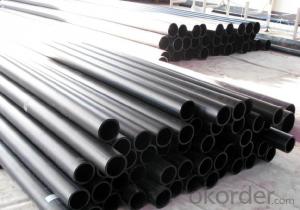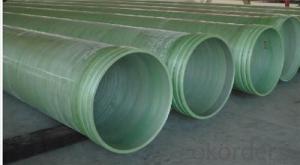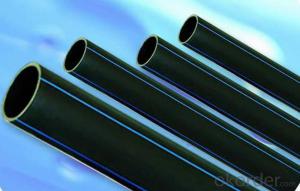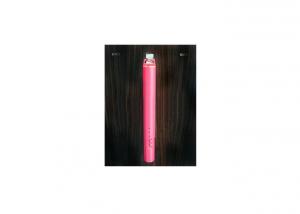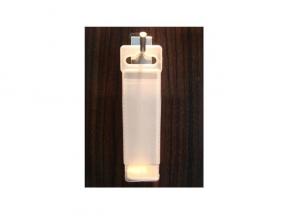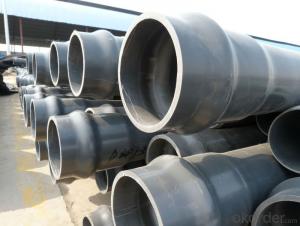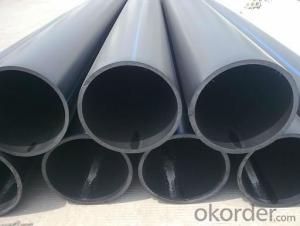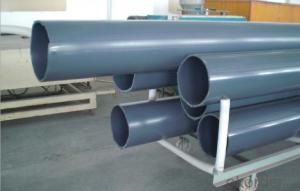Plastic Tubes HDPE Pipe ISO4427-2000 DN63
- Loading Port:
- China Main Port
- Payment Terms:
- TT OR LC
- Min Order Qty:
- -
- Supply Capability:
- -
OKorder Service Pledge
OKorder Financial Service
You Might Also Like
Physical properties[edit]
Polyethylene is a thermoplasticpolymer consisting of long hydrocarbon chains. Depending on the crystallinity and molecular weight, a melting point and glass transition may or may not be observable. The temperature at which these occur varies strongly with the type of polyethylene. For common commercial grades of medium- and high-density polyethylene the melting point is typically in the range 120 to 180 °C (248 to 356 °F). The melting point for average, commercial, low-density polyethylene is typically 105 to 115 °C (221 to 239 °F).it is transprant.
Chemical properties[edit]
Most LDPE, MDPE and HDPE grades have excellent chemical resistance, meaning that it is not attacked by strong acids or strong bases. It is also resistant to gentle oxidants and reducing agents. Polyethylene burns slowly with a blue flame having a yellow tip and gives off an odour of paraffin. The material continues burning on removal of the flame source and produces a drip.[3] Crystalline samples do not dissolve at room temperature. Polyethylene (other than cross-linked polyethylene) usually can be dissolved at elevated temperatures in aromatic hydrocarbons such as toluene or xylene, or in chlorinated solvents such as trichloroethane or trichlorobenzene.[4]
GB/T13663-2000:
| PE63管材规格 | |||||
| 公称 外径dn,mm | SDR33 | SDR26 | SDR17.6 | SDR13.6 | SDR11 |
| 公称压力 PN,Mpa | |||||
| 0.32 | 0.4 | 0.6 | 0.8 | 1.0 | |
| 公称 壁厚 | 公称 壁厚 | 公称 壁厚 | 公称 壁厚 | 公称 壁厚 | |
| 16 | 2.3 | ||||
| 20 | 2.3 | 2.3 | |||
| 25 | 2.3 | 2.3 | 2.3 | ||
| 32 | 2.3 | 2.4 | 2.9 | ||
| 40 | 2.3 | 2.3 | 3.0 | 3.7 | |
| 50 | 2.3 | 2.9 | 3.7 | 4.6 | |
| 63 | 2.3 | 2.5 | 3.6 | 4.7 | 5.8 |
| 75 | 2.3 | 2.9 | 4.3 | 5.6 | 6.8 |
| 90 | 2.8 | 3.5 | 5.1 | 6.7 | 8.2 |
| 110 | 3.4 | 4.2 | 6.3 | 8.1 | 10.0 |
| 125 | 3.9 | 4.8 | 7.1 | 9.2 | 11.4 |
| 140 | 4.3 | 5.4 | 8.0 | 10.3 | 12.7 |
| 160 | 4.9 | 6.2 | 9.1 | 11.8 | 14.6 |
| 180 | 5.5 | 6.9 | 10.2 | 13.3 | 16.4 |
| 200 | 6.2 | 7.7 | 11.4 | 14.7 | 18.2 |
| 225 | 6.9 | 8.6 | 12.8 | 16.6 | 20.5 |
| 250 | 7.7 | 9.6 | 14.2 | 18.4 | 22.7 |
| 280 | 8.6 | 10.7 | 15.9 | 20.6 | 25.4 |
| 315 | 9.7 | 12.1 | 17.9 | 23.2 | 28.6 |
| 355 | 10.9 | 13.6 | 20.1 | 26.1 | 32.2 |
| 400 | 12.3 | 15.3 | 22.7 | 29.4 | 36.3 |
| 450 | 13.8 | 17.2 | 25.5 | 33.1 | 40.9 |
| 500 | 15.3 | 19.1 | 28.3 | 36.8 | 45.4 |
| 560 | 17.2 | 21.4 | 31.7 | 41.2 | 50.8 |
| 630 | 19.3 | 24.1 | 35.7 | 46.3 | 57.2 |
- Q: Are plastic tubes resistant to cracking?
- Yes, plastic tubes are generally resistant to cracking due to their inherent flexibility and durability.
- Q: Are plastic tubes suitable for pneumatic conveying systems?
- Yes, plastic tubes are suitable for pneumatic conveying systems. They offer several advantages such as being lightweight, corrosion-resistant, and easy to install. Plastic tubes also have good flexibility, allowing them to navigate bends and curves more easily. Additionally, they are cost-effective and can handle a wide range of materials, making them a popular choice for pneumatic conveying applications.
- Q: Are plastic tubes impact-resistant?
- Yes, plastic tubes can be impact-resistant depending on the type of plastic used and the thickness of the tube walls.
- Q: do anyone remember the plastic tube roll that you put on your b&w tv to mimic a color set?
- yes, and they were just awful.
- Q: Can plastic tubes be used for storing personal hygiene items?
- Yes, plastic tubes can be used for storing personal hygiene items. They are commonly used for packaging and storing products like toothpaste, lotions, creams, gels, and other similar items. Plastic tubes offer convenience, portability, and protection for personal hygiene products.
- Q: Are plastic tubes suitable for pharmaceutical packaging?
- Yes, plastic tubes are suitable for pharmaceutical packaging. They offer various advantages such as durability, flexibility, and resistance to moisture and chemicals. Additionally, plastic tubes can be easily sealed to ensure product integrity and prevent contamination.
- Q: What are the problems to be overcome in the development of plastic pipe industry?
- Plastic pipe industry development prospects are relatively good, especially good performance of new plastic pipes, better prospects for development.
- Q: Can plastic tubes be used for packaging fragile items?
- Yes, plastic tubes can be used for packaging fragile items. Plastic tubes provide a protective and secure packaging option, helping to prevent breakage and damage during transportation or storage. They can be customized to fit the specific dimensions of the fragile item, ensuring a snug and cushioned fit. Additionally, plastic tubes offer durability and resistance to impact, making them suitable for protecting delicate items.
- Q: i have to know, because otherwise the hoover is rendered completely useless, the bottle cap is the same size as the hoover tube and i do not have a stick or long object long enough with which to poke it out :(please help me
- Have you tried blowing it out. Wipe the opening on the opposite side of the tube where the cap is with some rubbing alcohol till it's clean and let dry. Then take a deep breath and blow through the tube, sealing the tube by pressing it against your face. This should dislodge the cap enough to where you should be able to shake the cap out.
- Q: What is the level of flexibility of plastic tubes?
- Plastic tubes have a high level of flexibility, allowing them to be easily bent, twisted, or stretched without breaking.
Send your message to us
Plastic Tubes HDPE Pipe ISO4427-2000 DN63
- Loading Port:
- China Main Port
- Payment Terms:
- TT OR LC
- Min Order Qty:
- -
- Supply Capability:
- -
OKorder Service Pledge
OKorder Financial Service
Similar products
Hot products
Hot Searches
Related keywords
